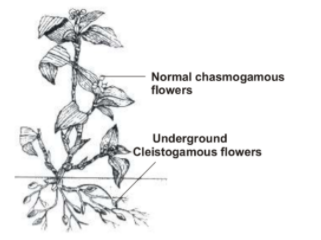
Both chasmogamous and cleistogamous flowers are present in:
a. Helianthus
b. Commelina
c. Rosa
d. Gossypium
Answer
436.6k+ views
Hint: Open type of flowers are found in sunflower and cotton plants.
Closed types of flowers are found in groundnut, pea, etc.
In open flowers, petals should be colourful and contain scent to attract the pollinators.
Complete answer:
In order to solve this question, we need to know about the chasmogamous and cleistogamous flowers.
In chasmogamous plants, flowers open at the time of maturity. These flowers are usually cross-pollinated but sometimes they are self pollinated. For the purpose of self-pollination, male and female reproductive parts are present in the same flower, which is known as homogamy. They require external agents for the pollination. These flowers possess showy petals and presence of scent to attract pollinators. The chasmogamous flowers are present in Convolvulus, Mirabilis, Helianthus, Catharanthus, etc.
The self pollination is the process of transfer of pollen grains from anther to the stigma of the same flower (autogamy) or the stigma of another flower of the same plant (geitonogamy). On the other hand, cross pollination is the transfer of pollen grains from anther to the stigma of another plant of the same or different species.
In cleistogamous plants, the bisexual flowers remain closed and never gets open. These flowers are usually self-pollinated. These flowers are homogamous. They do not need any external agent for the pollination. These flowers do not possess showy petals and presence of scent to attract pollinators. The cleistogamous flowers are present in Pisum, Lathyrus, groundnut, etc.
In Commelina two types of flowers are present-
(a) Chasmogamous flower: These are open aerial flowers.
(b) Cleistogamous flower: These are closed underground flowers.
Such a type of flower is known as chasma cleistogamous flowers and this phenomenon is known as amphicarpy. In such flowers, the anthers and stigma present close to each other. On the maturation and bursting of anther, pollen grains come in contact with the stigma for the purpose of pollination.
In Helianthus (sunflower), Rosa (rose) and Gossypium (cotton), flowers are chasmogamous.
So, the correct answer is option B, Commelina.

Note: Cleistogamous flower prevents the cross pollination in bisexual or hermaphrodite flowers.
The conditions for self pollination in plants are bisexuality, homogamy and cleistogamy.
In chasmogamous flowers, both self and cross pollination can be present.
Closed types of flowers are found in groundnut, pea, etc.
In open flowers, petals should be colourful and contain scent to attract the pollinators.
Complete answer:
In order to solve this question, we need to know about the chasmogamous and cleistogamous flowers.
In chasmogamous plants, flowers open at the time of maturity. These flowers are usually cross-pollinated but sometimes they are self pollinated. For the purpose of self-pollination, male and female reproductive parts are present in the same flower, which is known as homogamy. They require external agents for the pollination. These flowers possess showy petals and presence of scent to attract pollinators. The chasmogamous flowers are present in Convolvulus, Mirabilis, Helianthus, Catharanthus, etc.
The self pollination is the process of transfer of pollen grains from anther to the stigma of the same flower (autogamy) or the stigma of another flower of the same plant (geitonogamy). On the other hand, cross pollination is the transfer of pollen grains from anther to the stigma of another plant of the same or different species.
In cleistogamous plants, the bisexual flowers remain closed and never gets open. These flowers are usually self-pollinated. These flowers are homogamous. They do not need any external agent for the pollination. These flowers do not possess showy petals and presence of scent to attract pollinators. The cleistogamous flowers are present in Pisum, Lathyrus, groundnut, etc.
In Commelina two types of flowers are present-
(a) Chasmogamous flower: These are open aerial flowers.
(b) Cleistogamous flower: These are closed underground flowers.
Such a type of flower is known as chasma cleistogamous flowers and this phenomenon is known as amphicarpy. In such flowers, the anthers and stigma present close to each other. On the maturation and bursting of anther, pollen grains come in contact with the stigma for the purpose of pollination.
In Helianthus (sunflower), Rosa (rose) and Gossypium (cotton), flowers are chasmogamous.
So, the correct answer is option B, Commelina.

Note: Cleistogamous flower prevents the cross pollination in bisexual or hermaphrodite flowers.
The conditions for self pollination in plants are bisexuality, homogamy and cleistogamy.
In chasmogamous flowers, both self and cross pollination can be present.
Recently Updated Pages
Master Class 12 Business Studies: Engaging Questions & Answers for Success

Master Class 12 English: Engaging Questions & Answers for Success

Master Class 12 Social Science: Engaging Questions & Answers for Success

Master Class 12 Chemistry: Engaging Questions & Answers for Success

Class 12 Question and Answer - Your Ultimate Solutions Guide

Master Class 12 Economics: Engaging Questions & Answers for Success

Trending doubts
Give 10 examples of unisexual and bisexual flowers

Draw a labelled sketch of the human eye class 12 physics CBSE

Differentiate between homogeneous and heterogeneous class 12 chemistry CBSE

Write a short note on Franklands reaction class 12 chemistry CBSE

Differentiate between insitu conservation and exsitu class 12 biology CBSE

What are the major means of transport Explain each class 12 social science CBSE




